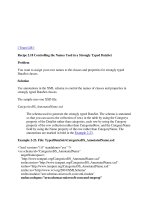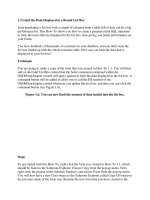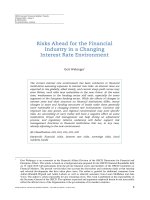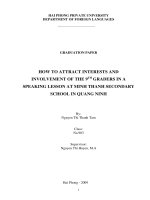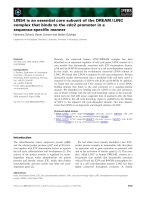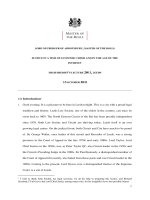The teaching techniques in a reading comprehensive lesson
Bạn đang xem bản rút gọn của tài liệu. Xem và tải ngay bản đầy đủ của tài liệu tại đây (171.24 KB, 12 trang )
A. PROPOSITION
Nowadays English has affirmed the role and the importance in schools, so
raising the quality of teaching is the most important issue. Reform teaching
programme is applied, a wide range of problems of English teaching methodology
also arise. The question is: How can the students comprehend the whole
knowledge and use it competently?
Learning English is merely to learn a language . Wanting to use this language
skillfully, learners need to practice four basic skills: Listening - Speaking Reading - Writing. Reading skill plays the important role because it decides
whether the students understand the contents they have just read or not. As early as
in 6th grade, students were acquainted with short, easy to understand texts . The
higher the program gets, the more rigorous training skills are required. If teachers
do not have good teaching methods, they will not convey all the content of the
lessons. On the other hand the content of the reading texts is often long and
contains a lot of new words which are easy to make students discouraged.
To meet the demand, each teacher needs to find the best method which is
suitable for real situations and their students.
Being a teacher of English, with the desire to bring my knowledge to convey
to my students, and find out my own teaching method, I would like to present to
the educational scientific council this year the theme: "The teaching techniques in
a reading comprehensive lesson" in lower secondary school.
1
B. Solutions
I. THEORITICAL BASES.
1. The importance of teaching reading skills:
Reading is an important and neccessary skill in language teaching and learning
in all grades. In foreign language classes students read to get information, to check
the events to find the answers to questions or clarify a particular issue ... If students
cannot read, they will not receive and remember data and information permanently.
Everyday the students store information through letters, through learning from
text books, from the advertisements, instructions, manual machines, equipment,
news through newspapers, TV ... leaning to read means learners practise to
recognize the letters and meaning of the information being read.
It is more convenient for Vietnamese people to learn English than some other
ethnic groups such as Chinese, Thai, Russian, Arabic people ... Since the system
Vietnamese and English are almost the same, just some very little different alphabet
Z, W, J, F ... Depending on the purpose of the lesson, the teacher can teach reading
in several diffrent ways:
- The reader turns to read out loud (often applied in the beginner class and
young people)
- The teacher reads, students read in books.
- Students read silently
- In classes for beginners, students must be familiar with the combination of
letters in the new writing system and based on the information given to understand
the semantics of the words, phrases, clauses and the English sentences.
The reading aloud a sentence or a text in English is a hard job for Vietnamese
because English is not spelled as easily as Vietnamese. In addition, there are many
other factors also affect the reading aloud such as stresses, and intonation details
because these factors can influence the expression of the meaning of words and
sentences.
In foreign language classes, reading is usually organized to consolidate the
previous practice activities as listening and speaking activities.
The reading in class under that method is often forced, because teachers often
give the students exercises to perform. To teach reading more effectively and in a
more communicative way, teachers must have the preparations and make students
feel the need to read.
The reading texts should be accurated about language, rich and diverse in
genre, with content relevant and enriching life experiences of students, causing
excitement for reading not boring. Directions perform exercises need to notice the
reading techniques and discuss the expansion of the reading subject.
2. A number of factors affect the teaching: [1]
2
According to some experts, such as Colvin & Root (1981); Havernson & Haynes
(1982); Mege (1977); Thornis (1970) ... teachers need to pay attention to the
requirements that affect the success of teaching reading skill to beginners, such as:
- The ability to concentrate in a minimum time of students.
- Ability to read and understand the instructions.
- Ability to read by yourself and read with others.
- Ability to co-operate with their classmates.
- Ability to name each item in the picture.
- Ability to read from left to right and read from top to bottom.
- Ability to organize, classify (same / different).
- Ability to present the skills of function as ingenuity, clumsiness.
- Ability to read a long paragraph .
- Ability to distinguish from left to right, from top to bottom.
- Ability to understand and shape symbols.
- The ability to read the expression through gestures, facial expressions, body.
- The ability to realize the idea from a picture expressing a real object.
- Ability to recognize sound symbols and images.
- Ability to recognize that the speech can be written.
- Ability to recognize affirmative setences and questions that students have heard.
- Ability to recognize and speak basic intonation patterns.
- The ability to recognize the significance due to two-dimensional objects shown
(books, paintings, photos ...)
These capabilities can be achieved through the process of training reading and
writing that students perform. The fact that students can get results quickly or
slowly depend on the background knowledge that they have already learnt in their
mother tongue, their health and acuity.
There are also 8 other factors which affect the learning reading skill in a foreign
language such as:
- Students who do not have certain secondary education ,they will find difficulty
in transfering knowledge and generalization. Therefore they need to be guided
carefully reading to increase attention .
- Students often react in negative way to pages that are printed densely.
- Students tend to concentrate the effort to decode the new words , while limited
attention to the interpretation of texts.
- Teachers can anticipate that students will have difficulty in reading and
understanding the contents of text if text is not familiar with them.
- Experience speaking of students are used to decode texts according to age and
life experiences of the students for learning languages.
3
- Reasoning ability, talk and understand because the conceptions such as words,
phrases,sentences, sound and other conceptions have a positive impact on the
success of the initial study.
- The level of understanding the types of documents, depend on the age and
experience of students for national cultures that is being learned.
- Students study foreign languages ,they need to explane the involved
metaphors in writing, the idioms, and the cultural information of the languages
which the peoples have learned more than the students learn their native language.
II. PRACTICAL BASES
1. The reality of the teaching reading comprehension lessons in English at
secondary schools.
Although English has become an official subject at school, the promotion of its
benefits has not been taken much interest. Partly due to the limited facilities and
teaching aids, but mostly due to the quality of teaching is not high, so it cannot
attract the charm to learn of students. This expresses in reading lessons. Students
always refuse to read a text which is full of new words. On the other hand, most
students are only interested in the meanings of words without pay attention to the
content of the reading texts. As a result they can not answer correctly questions
about the reading. Therefore the quality teaching decreases, does not satisfy the
requirements of the programs.
In addition, the role of the teacher can not mention the quality of teaching has
improved or not, teaching methods are renovated to suit each lesson, each student .
In the old textbooks, reading skill is trained simultaneously with the skills of
listening, speaking and writing, new words and new structures in each reading
lesson with familiar topics which students have already known ,teachers only make
up the questions and ask students to answer . After the English textbooks were
compiled again, reading skill is trained separately, innovation in teaching methods
has been focused and compelled . Many new topics are mentioned, the number of
words increases. Students feel overwhelmed, so the old method is no longer
suitable. Therefore, the teacher plays a key role in this : how to teach to both meet
real life requirements and improve the quality of their learning.
III- IMPLEMENTATION MEASURES
Techniques used in each stage of a reading comprehensive lesson:
In teaching we can divide teaching reading into the following stages:
1. Pre – Reading stage:
In this stage, teachers should introduce extensively about topics which they are
going to read, remind the information relating to students’ experiences through a
number of activities such as: give prediction questions and help students predict the
content of the text . If the text is a conversation, the teacher may mention the place,
the number of participants, and the relationship between people in the dialogue.
4
(family members, friends, acquaintances .. .). If it is an excerpt of a story, teacher
can ask one or some students to remind the main events before.
In some textbooks there are usually pictures along with texts, teachers should
use these pictures to draw students’ attention to the content of the text by helping
them to predict ideas and language that will be used in this lesson.
- teacher usually mentions a few suggestive questions in this stage. The questions
should follow the order of events or developments theoretical of readings. These
questions present the basic structures of the reading and the means help students to
predict the content of the reading, then read the text more naturally.
Sometimes, teachers can ask students to skim the reading to have some general
notion of information in the text. By such activities : teachers can inspire students
"desire to read" and make students interested in the new topics.
Activities in this stage may vary according to the real situation of each school
and student level. The teacher can make one or two activities in this period.
Example 1: English 8 - Unit 9: A first - aid course [2]
Teacher: You are going to read a text about first - aid, look at the pictures (the
illustrative pictures hang on the board)
Can you guess what happened to the people in each picture? what do you call
these in English?
Can you give first - aid instructions for each case? If not, ask teacher to
explain it to you then have a class discussion about it.
Example 2 : English 8 - Unit 10: Recycling [3]
section: Read
Teacher: You are going to read a text about recycling. Imagine That there are
millions ton of rubbish eliminated in our environment each day.
How can they damage our lives if they are not recycled?
What kind of rubbish can we recycled?
What kind of rubbish can we reuse or reduce?
The following words may help: car tires, bottles, glass, drink cans, compost, refill,
break up, melt. Use dictionary or ask your teacher about the new words.
- Students mark in the column "right" or "wrong" some given information :
Read the statements and tick True or False.
English 8 - Unit 11: Travelling around Vietnam [4]
True False
a. Nha Trang is the seaside resort.
....... ........
b. Đa Lat is recognized as a world Heritage Site by Unesco.
....... ........
c. You can visit tribal villages in Sapa .
........ ........
d. There are flights from Da lat to Hanoi everyday.
........ ........
e. Ha Long Bay is known as the city of Enternal Spring.
........ ........
5
- Students guess and fill in some words, the appropriate language in the blanks of
a given passage:
Example: English 8 - Unit 4: Our Past [5]
Little Pea’s father is............... . After his wife ...................He married again.
The step mother was very....................to Little Pea. She had to do chores all day.
Her father was very upset. He soon ...................of the broken heart . In the fall, the
village held its harvest...................... the Prince wanted to................his wife from
the village Little Pea didn’t have new clothes . A fairy appeared and
magically changed Little Pea’s rags into....................As running to the festival, she
dropped her................The Prince found her shoe and wanted to........... her
- Students discussed before and give personal opinions on the subject of the
essay.
Example: You are going to read a text about the ways to learn language. Look at
the pictures. How do the people learn languages? Which is the best way to learn
language?
- Predicting the meaning of some words or look up them in the dictionary.
Example: English 6: Unit 16: Man and the Environment [6]
These words are necessary for your understanding of the text on “Environment”.
Are they similar to you? If not , look up their meanings in a good dictionary
destroy
gas
waste
burn
trash
coal
pollute
oil
- Teachers can organize games (use of words related to the lesson such as
Bingo, questioniares ...........)
2. While- Reading Stage:
In this stage, activities are organized to help students practice reading
comprehension skill , some other reading skills that are combined in reading
comprehension skills.
The skills which are generally used in this stage are intensive reading and read
extensive reading. Intensive reading means readers understand all content that they
have read and can answer questions about specific information that is expressed
through the text.
Extensive reading means students read for main ideas of the text; they do not
need to understand every word or every idea. Intensive reading helps students read
extensive more effectively. On the other hand, extensive reading will also make
students more confident when exposing to the exact texts.
For long reading texts, teachers ask students to read extensively in a few
paragraphs and read intensively in the other paragraphs. If we make students read a
too long text intensively, they will lose their interest and there will not be enough
time to train skimming skill.
6
Readings in the old textbooks are usually compiled carefully, selectively and
there is a limitation of language for the students to read intensively. However, in the
new textbook, reading texts are diverse and precise. With extensive reading,
students will understand main ideas of the reading text even though their English is
not so good.
In grade 8th,9th, we shouldn’t ask students read aloud the text because it is
so difficult for them. A specific reading text has many new words which students
do not know how to pronounce, the conversation may require an understanding of
the structures, special intonation that students do not know. Reading a text which
hasn’t been prepared in advance will make students feel less confident, hesitant, or
mispronounce, which will affect other students. While reading aloud texts many
students will pay attention to the pronounciation more than the meaning of the text,
so that students can read well but understand little, even they do not understand
what they are reading.
First , the teacher should read the whole text or let students hear the tape
which is read by native speakers, then has students read the text silently. Teachers
will help students who have trouble while reading. Students should be asked to
prepare before reading aloud texts so that their reading doesn’t take much time and
inefficiently.
Teachers also need to change reading techniques. In extensive reading, silent
reading is very appropriate and effective. Teacher limits the reading time and then
give some questions to check students’comprehension . Most of the literature
discourse, discussion is written to read silently. only genres like poetry, children's
songsand conversation are written to read aloud. Therefore, teachers should
depend on the category of reading texts to apply suitable reading techniques. If we
ask students to read aloud, they should be prepared in advance and we can make
changes in a number of ways as follow:
- For classes of beginning level, teachers read first , the class repeat sentence by
sentence.
- In mass classes, apart from repeating teachers, students can read after the
tape. Repeating the tape is often harder than repeat the teachers because the voice
in the tape is often more inaudible than the teacher’s voice.
- The teacher read a passage, then the whole class reread.
- A student read sentence by sentence after the teacher.
- The class is divided into groups of two or more . Each group prepare a
section, later a representative of each group will read a passage. In case the reading
is a dialogue, groups cast and prepare. Teachers discusses with the group that have
difficulty with pronunciation (stress, rhythm and intonation). Then each group will
play the role to practice before the whole class .
7
During the lesson teachers should raise a number of questions to guide students’
reading and check their understanding of the information in the text, and also to
measure the level of students, so teachers can explain unclear details. The content
of questions need to direct the attention of students. Teacher needs to read
unknown sample before or while students are reading.
Ex: Read and arrrange the paintings in the right order, complete the table and
answer the questions.
English 8: Unit 13: Lesson: 3 Read
[7]
* Read and draw a picture to express the guide.
Example: Assignment: English 6: Unit 9: The body
Part A: Part of the body
Exercise: Draw the girl or the boy
a. That is his head
That is his chest
Those are his hands
Those are his shoulders
Part B: Faces
b. United has an oval face
She has black hair dragon
She has brown eyes
She has a small nose
She has thin lips
* Read and record the information under another form. Read summarize the main
idea of the lesson.
3. Post-reading Stage:
8
During this stage students will participate in a number of activities to expand
the exploitation of the text and develop some other skills besides reading skills.
Exercise may include:
+) Fill a available table to help students focus in the main points of the reading,
especially for you with many statistics and data.
Example: English 8: Unit 12: A vacation abroad
Section: Read
After students read and answer questions, teachers can ask students to make a
statistical table.
Places
What she did and saw
a. Hawaii
Went swimming, visited Kilauea Volcano
b. New york
c. Chicago
d. Mount Rushmore
e. San Francisco
+ Answer questions relating to individual experiences, emotions, attitudes and
explain.
Example: English 8: Unit5: Study habit
Lesson: Read
After finishing the reading teacher can ask some questions about vocabulary
learning experience of students and ask them to answer.
- How should you learn words?
- What is necessary in learning words?
- In your opinion, what is the best way to learn words?
- Do you often learn words in one way or different ways?
+ Write a summary , a review basing on the information in the reading.
III. TESTING
After a long time of anxiety about the method chosen, I do not know whether
my students have made progress in their studies. Through the exam, they have
obtained more objective results than before.
These are the survey results of 2 classes 8A1, 8A2 the first semester of the school
year 2016- 2017:
1. The beginning of the 1st semester exam results:
Class Total
Excellent Good
Average
Weak
poor
Students N0 %
N0 %
N0 %
N0 %
N0 %
8A1 29
5
17,2 18 62
6
20,8 0
0
8A2
30
7
23,3 17
56,
6
6
20
0
0
9
2. the 1st semester exam results:
Class Total
Excellent Good
Students No %
No %
8A1 29
9 31
17 58,
6
8A2 30
10 33,3 14 46,6
Average
Weak
No %
No %
3
10,4 0
poor
No %
0
6
0
20
0
By applying the techniques in teaching reading skill as mentioned above, I
realize that my students have made a lot of progress, their exam results are much
higher than before. That really motivates me to constantly strive to achieve better
results.
* SUGGESTIONS
In order to have a successful reading skill lesson, teachers are required to
know the harmony between steps in the teaching process with the amount of
knowledge in textbooks.
So as to make the lesspn more lively , apart from specific teaching methods,
teachers should use pictures as illustration, visual aids and extra board. Teacher
should take advantage of the exercises to provide an opportunity for all students to
make them understand the lesson deeply. Moreover, with a view to inspiring
students in learning, teachers can tell them stories relating to the lesson, suggest the
main content to students before they study the lesson. Although I have achieved
positive results, I think this approach still has a lot of things that need correcting
and adding.Therefore, I would like to receive comments from colleagues so that I
can promote my teaching method better.
D. CONCLUSION AND SUGGESTIONS:
1 / To the school managing board:
- Facilitate the facilities for teaching, purchase more reference books for teachers to
teach, improve themselves ; equip additional teaching aids such as pictures, videos,
CDs, VCDs .. .
- Create a reasonable timetable so that students can have classes weekly to
improve teaching quality and train gifted students.
- reward teachers deservedly for teaching effectively and students who win prizes
in the examination for excellent students at district level and provincial level.
2 / To the District Department of Education and Training:
- Organize proffessional skill improving workshops for teachers in the district at the
beginning of each school year.
- Organize meetings for students in groups of schools to speak English in order to
create more fun in learning, to create positive learning motivation for students.
10
- Select graded A themes and initiatives in the district to provide teachers to study
and apply in their teaching.
ASSESSMENTS BY THE SCHOOL
SCIENTIFIC COUNCIL
Quang Xuong, April 15th 2018
I swear this is my own experience
initiative not to copy others’content
Written by:
LÊ VĂN GIÁO
11
REFERENCE BOOKS
[1]. A number of factors affect the teaching:
- Colvin & Root (1981); Havernson & Haynes (1982); Mege (1977); Thornis
(1970) ...
[2].Textbook. English 8 - Unit 9: A first - aid course
[3]. Textbook. English 8 - Unit 10: Recycling
[4]. Textbook. Travelling around Vietnam
[5]. Textbook. English 8 - Unit 4: Our Past
[6]. Textbook. Unit 16: Man and the Environment
[7]. Pictures : Internet
12
